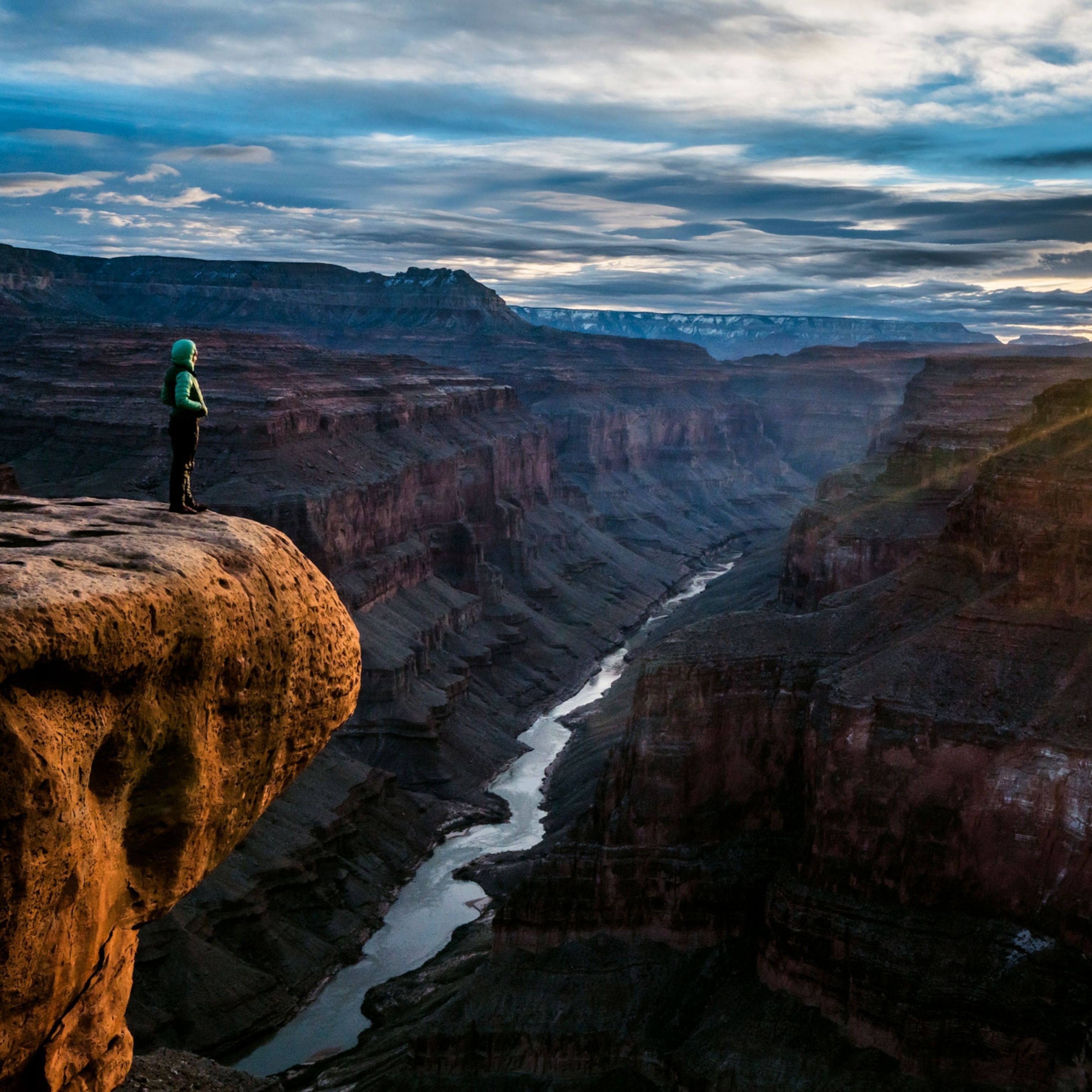
Biden expected to reverse Trump’s order to shrink Utah national monuments
Little on-the-ground damage to the parks has been seen since they were shrunk in 2017. But conservationists say the sooner they can be properly protected again, the better.
On Dec. 4, 2017, President Donald Trump announced an unprecedented move in a presidency that would prove to be full of them. Standing before Utah’s state capitol in Salt Lake City, he signed a proclamation drastically shrinking two sprawling national monuments in southern Utah that his Democratic predecessors had established.
“I’ve come to Utah to take a very historic action to reverse federal overreach,” he said, as he slashed Bears Ears National Monument by 85 percent and Grand Staircase-Escalante National Monument nearly in half. (Read about the controversy surrounding the monuments in National Geographic Magazine.)
Sometime soon after his inauguration, however, President Joe Biden is expected to act to reverse those reversals. “As President,” his campaign promised, “Biden will take immediate steps to reverse the Trump Administration’s assaults on America’s natural treasures,” including Bears Ears and Grand-Staircase Escalante.
For conservation groups, that would be genuinely good news. So far, they have seen few lasting consequences of Trump’s actions, which were intended to increase access and encourage exploitation of natural resources within the monuments. “The optimistic part,” says Mike Popejoy, Utah public lands director at Grand Canyon Trust, “is that with the reversion to the original boundaries, no on-the-ground damage on any large scale has been done.”
But restoring the boundaries will be the easy part. In the months and years that follow, the Biden team will have to create its own plan to manage a spectacular red-rock desert landscape that is sacred to many southwestern Native American tribes. This means not only rolling back unwelcome changes from the Trump era, but also establishing and enforcing protections that most everyone agrees were insufficient even before Trump slashed the monuments.
With the recent, historic nomination of U.S. Representative Deb Haaland (D-New Mexico) as the nation’s first Native American Interior Secretary, expectations are sky high. “We understand that something’s going to happen on the first day,” says Woody Lee, executive director of Utah Diné Bikéyah, a tribal advocacy group that pushed for the creation of the Bears Ears monument. “We’re pretty much ready to go.”
Rhetoric exceeded reality
President Barack Obama created the 1.35-million-acre Bears Ears monument in December 2016, shortly before leaving office. President Bill Clinton established Grand Staircase-Escalante, which covers 1.88 million acres, in 1996. Both used their authority under the 1906 Antiquities Act, which permits presidents to protect “objects of historic and scientific interest” on federal land without input from Congress.
When Trump reduced the monuments, he argued that the previous administrations had abused that authority. What remains most unclear, however, is whether the Antiquities Act grants presidents the authority to curtail the monument designations of their predecessors.
Early last year the Bureau of Land Management (BLM), which oversees the two Utah monuments (the Forest Service also manages a portion of Bears Ears), released final management plans that aimed to “restore a prosperous future” for citizens and businesses seeking access to the reduced monuments and the land excised from their original borders.
While the land removed from the two monuments would remain under federal management, the Trump plans allowed new opportunities for oil and gas leasing, mining, and grazing. And inside the “right-sized monuments,” as well as outside Grand Staircase, the Trump plans lifted some limits on recreational access, designed to protect sensitive ecology and more than 100,000 ancestral Puebloan sites and artifacts.
The Trump plans took more than two years to put into place. Conservation advocates expect a similar timeline for the anticipated changes under Biden. “Walking things back takes time,” says Josh Ewing, executive director of Friends of Cedar Mesa, a Bears Ears conservation group.
In the meantime, the Trump rules hold, and conservationists at both monuments worry about ongoing potential for damage. Given the Trump Administration’s short tenure, many of the fears raised by his 2017 proclamation were not realized. The new management plans made land excised from the monuments available for energy development, for instance—but the BLM held no oil and gas lease sales at either monument.
In the weeks before the 2020 election, the state of Utah did issue oil and gas leases, good for 10 years, on 2,460 acres of state land that were surrounded by (though not technically part of) the original Bears Ears monument. But while the leases give energy companies the rights to drill even after the monument is restored, they might yet be exchanged for leases on oil- and gas-rich federal land somewhere outside the monument. And even if the leases aren’t exchanged, it would, for now, be challenging to turn a profit on them, because the sites are remote and difficult to drill.
“With oil prices as low as they are now, it’s unlikely that they’d get developed,” says Ewing. If those 10-year leases expire without being drilled, there will be no remaining threat of oil and gas extraction within the boundaries of the restored Bears Ears monument.
Prospectors have also staked a “handful” of mining claims in areas cut from both monuments, says Stephen Bloch, legal director for Southern Utah Wilderness Alliance. Two small mines did begin operating: a five-acre, open-pit alabaster quarry at Grand Staircase, which completed operations last year, and the one-acre “Easy Peasy” mine, which reopened a formerly closed uranium and vanadium shaft on land cut from Bears Ears. Due to a paperwork violation, the mine is currently shuttered, but the operator is seeking to reopen. “Even though the footprint from the mine is relatively small,” says Bloch, “it will take decades to reclaim this damage.”
Other changes since 2017 have proved less consequential. While the Trump plans opened the door to more livestock grazing—including some allotments in Grand Staircase that had been “permanently” retired after the creation of the monument in 1996—the BLM issued no new permits.
“I don’t see any changes at all as far as the land itself,” says Garfield County Commissioner Leland Pollock, a rancher who supported the reductions. “The land is still there. People can still visit it. It’s not being destroyed.”
The new regulations also permitted “chaining”—the mechanical clearing of pinon-juniper forests that have encroached on grazing lands. But in the end, no projects were approved.
“It was less than everybody feared,” says Bloch. “Like so many things under Trump, the rhetoric exceeded the reality.”

Too much love
Perhaps the biggest concern now, for monument advocates, is the sheer number of people and recreational vehicles flooding into both monuments, thanks to the controversy surrounding them and pent-up wanderlust during the pandemic. “I fully expect this spring will be the busiest season Bears Ears has ever seen,” says Ewing.
Well before the Trump reductions, Bears Ears had suffered from unregulated and rising visitor numbers. The land in the monument descends from high, pine-studded mesas to dry sandstone canyons laden with ancient native artifacts—rock art, shelters, potsherds, burial grounds—that are sacred to many southwestern tribes.
“This is our church and our hospital,” says Utah Diné Bikéyah’s Lee, who is a member of the Navajo Nation. “This is our classroom. This is the place that sustains us both foodwise and spiritually. It is a place of healing.”
The Trump plans, however, permitted even more access to both the monuments and to the land cut from Grand Staircase. The plans allowed larger groups of visitors and more camping and off-road vehicle access in sensitive areas, while initiating few efforts at tourist education and management.
“It’s been four years, and there still is not even a sign when you drive into the monument” at Bears Ears, says Ewing. “The new plan doesn’t give Bears Ears the kind of protections that a national monument deserves and that other monuments receive around the country.”
Both areas have, historically, seen minimal BLM oversight. Until 2016, only one law enforcement ranger oversaw the entire Bears Ears acreage. Grand Staircase, facing unrelenting opposition from local politicians and the gutting of public lands budgets on the federal level, now scrapes by with roughly a quarter of its original staff and funding.
“Our budgets just continued to get tighter and tighter and tighter,” says Carolyn Shelton, who worked at the monument until 2016. Adds Grand Staircase Escalante Partners director Sarah Bauman: “There’s a system failure that’s gone on that’s not just about Trump’s rejection of the boundaries.”
Pollock, the county commissioner, agrees with this assessment, though he argues that restoring the borders will also restore the same system failures—too much land, too little funding to manage it. “It was very dysfunctional before,” he says about Grand Staircase, “because it was nearly two million acres and a lot of what was in the monument is just sagebrush and rabbit brush and rangeland. All they’re doing, if they revert back to the old monument model, is making something that is working very well now into a dysfunctional mess.”
Advocates hope that the Biden team will find more funding to manage both monuments. They’re also hopeful that new management plans will reflect both updated science—for example, how wildlife corridors can preserve biodiversity and help species adapt to climate change—and a greater influence of tribal voices and perspectives.

The unresolved issue
On the day Trump reduced the monuments, tribes and conservation groups filed suit challenging the legality of the move. The Antiquities Act includes no language permitting future presidents to reduce monuments named by their predecessors; monument supporters argued that Trump had no power to do so.
The cases were consolidated in Washington, D.C., under U.S. District Judge Tanya Chutkan, an Obama appointee—but after three years and multiple briefs and motions, the parties are still awaiting a decision. “If the Biden Administration chooses to restore the monument proclamation, it essentially moots the case,” says Phil Hanceford, public lands conservation director at The Wilderness Society.
Still, legal questions remain. “Most of the last 100 years, it’s been a normative value in the federal government that once a monument is created, other presidents don’t go around and un-create them,” says Scott Berry, board vice-president and legal advisor at Grand Staircase Escalante Partners. “Now this normative value is in question and there are a lot of people in America that would like to see an answer.”
Continuing to press the case—perhaps, eventually, to the Supreme Court—does pose a risk, particularly with the court’s current conservative majority. But so, too, does a continuing back-and-forth between administrations and their public lands philosophies.
“My biggest concern,” says Friends of Cedar Mesa’s Josh Ewing, “is that this sacred landscape, which is undeniably important and worthy of conservation, is just going to become a political football that is going to get passed back and forth every time an administration switches from Democratic to Republican and back again."
Bauman, of Grand Staircase Escalante Partners, echoed the sentiment: “We’re looking for a resolution that will restore the monument in perpetuity.”
You May Also Like
Go Further
Animals
- Soy, skim … spider. Are any of these technically milk?Soy, skim … spider. Are any of these technically milk?
- This pristine piece of the Amazon shows nature’s resilienceThis pristine piece of the Amazon shows nature’s resilience
- Octopuses have a lot of secrets. Can you guess 8 of them?
- Animals
- Feature
Octopuses have a lot of secrets. Can you guess 8 of them? - This biologist and her rescue dog help protect bears in the AndesThis biologist and her rescue dog help protect bears in the Andes
Environment
- This pristine piece of the Amazon shows nature’s resilienceThis pristine piece of the Amazon shows nature’s resilience
- Listen to 30 years of climate change transformed into haunting musicListen to 30 years of climate change transformed into haunting music
- This ancient society tried to stop El Niño—with child sacrificeThis ancient society tried to stop El Niño—with child sacrifice
- U.S. plans to clean its drinking water. What does that mean?U.S. plans to clean its drinking water. What does that mean?
- Food systems: supporting the triangle of food security, Video Story
- Paid Content
Food systems: supporting the triangle of food security
History & Culture
- Heard of Zoroastrianism? The religion still has fervent followersHeard of Zoroastrianism? The religion still has fervent followers
- Strange clues in a Maya temple reveal a fiery political dramaStrange clues in a Maya temple reveal a fiery political drama
- How technology is revealing secrets in these ancient scrollsHow technology is revealing secrets in these ancient scrolls
- Pilgrimages aren’t just spiritual anymore. They’re a workout.Pilgrimages aren’t just spiritual anymore. They’re a workout.
- This ancient society tried to stop El Niño—with child sacrificeThis ancient society tried to stop El Niño—with child sacrifice
Science
- Soy, skim … spider. Are any of these technically milk?Soy, skim … spider. Are any of these technically milk?
- Can aspirin help protect against colorectal cancers?Can aspirin help protect against colorectal cancers?
- The unexpected health benefits of Ozempic and MounjaroThe unexpected health benefits of Ozempic and Mounjaro
- Do you have an inner monologue? Here’s what it reveals about you.Do you have an inner monologue? Here’s what it reveals about you.
- Jupiter’s volcanic moon Io has been erupting for billions of yearsJupiter’s volcanic moon Io has been erupting for billions of years
Travel
- This chef is taking Indian cuisine in a bold new directionThis chef is taking Indian cuisine in a bold new direction
- On the path of Latin America's greatest wildlife migrationOn the path of Latin America's greatest wildlife migration
- Everything you need to know about Everglades National ParkEverything you need to know about Everglades National Park
- Spend a night at the museum at these 7 spots around the worldSpend a night at the museum at these 7 spots around the world







